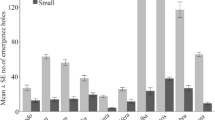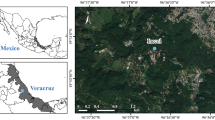Abstract
An hypothesis tout court is proposed to account for the association of cicadas (Homoptera: Cicadidae) with large-sized trees of the family Leguminosae in both climax forest formations and forest remnants in Central America. Based upon extensive field studies of these insects in Costa Rica, final-instar nymphal skins of many genera and species of Neotropical cicadas appear to be aggregated annually around individual large legume trees in a broad range of habitats in Costa Rica, and much of the reproductive behavior of the adult insects is also centered around these trees. A series of testable subhypotheses are generated based largely upon the assumption that cicadas, primarily through egg-placement behavior and nymphal feeding behavior, have coevolved with legume trees in climax forest formations of Central America, and perhaps elsewhere in the Neotropical Region. The “root crowns” of such trees, with some exceptions, might be optimal feeding sites for cicada nymphs in tropical forests.
Similar content being viewed by others
References
Allen, O.N., and Allen, E.K. (1981). The heguminosae: A source book of characteristics, uses, and nodulation.- Madison: UW Press, 812 pp.
Altieri, M.A., Letourneau, D.K., and Davis, J.R. (1982). Developing sustainable agroecosystems.- BioScience 33: 45–49.
Black, C.A. (1957). Soil-Plant Relationships.- New York: John Wiley & Sons.
Bollard, E.C. (1957). Composition of the nitrogen fraction of apple tracheal sap.- Aust J Biol Sci 10: 279–287.
Boyd, N.D., and Martin, M.M. (1975a). Faecal proteinases of the fungus-growing ant, Atta texana: properties, significance and possible origin. Insect Biochem 5: 619–635.
Boyd, N.D., and Martin, M.M. (1975b). Faecal proteinases of the fungus-growing ant, Atta texana: their fungal origin and ecological significance. J Insect Physiol 21: 1815–1820.
Bridges, J.R. (1981). Nitrogen-fixing bacteria associated with bark beetles.- Microb Ecol 7: 131–137.
Cheung, W.W.K., and Marshall, A.T. (1973). Water and ion regulation in cicadas in relation to xylem feeding.- J Insect Physiol 19: 1801–1816.
Denno, R.F., Raupp, M.J., Tallamy, D.W., and Riechelderfer, C.F. (1980). Migration in heterogeneous environments: differences in habitat selection between the wing forms of the dimorphic planthopper, Prokelisia marginata (Homoptera: Delphacidae).- Ecology 61: 859–867.
Denslow, J.S. (1980). Gap partitioning among tropical rainforest trees. In J. Ewel, ed., Tropical Succession, 47–55. Biotropica, Supplement to Vol. 12.
Dybas, H.S., and Lloyd, M. (1974). The habitats of 17-year periodical cicadas (Homoptera: Cicadae: Magicicada spp.).- Ecol Monogr 44: 279–324.
Ewel, J. (1980). Tropical succession: manifold routes to maturity. In J. Ewel, ed., Tropical Succession, 2–7. Biotropica 12: supplement.
Ewel, J., Berish, C., Brown, B., Price, N., and Raich, J. (1981). Slash and burn impacts on a Costa Rican wet forest site.- Ecology 62: 816–829.
Felker, P., and Bandurski, R.S. (1980). Uses and potential uses of leguminous trees for minimal energy output agriculture.- Econ Botany 33: 172–184.
Flenley, J. (1979). The equatorial rain forest: a geological history. England: Butterworth.
Gutschick, V.P. (1981). Evolved strategies in nitrogen acquisition by plants.- Amer Nat 118: 607–637.
Hardy, R.W.F., and Gibson, A.H. (1977). A Treatise on Dinitrogen Fixation. Vol. 4: Agronomy and Ecology, New York: Wiley.
Harper, J.L. (1977). Population biology of plants.- London: Academic Press.
Hartshorn, G.S. (1975). A matrix model of tree population dynamics. In F.B. Golley and E. Medina, eds., Tropical Ecological Systems: Trends in Terrestrial and Aquatic Research, 41–51. New York: Springer-Verlag.
Havelka, U.D., and Hardy, R.W.F. (1974). Legume nitrogen fixation as a problem in carbon nutrition. In W.E. Newton and C.J. Nyman, eds., First Internat Sympos in Nitrogen Fixation, 456–475. Wash State Univ Press, Pullman.
Hayman, D.S. (1980). Mycorrhiza and crop production.- Nature 287: 87–88.
Horsfield, D. (1977). Relationships between feeding of Pliaenus Spumarius (L.) and the amino acid concentration in the xylem sap.- Feel Entomol 2: 259–266.
Janos, D.P. (1975). Effects of vesicular-arbuscular mycorrhizae on lowland tropical rainforest trees. In F.E. Sanders, B. Mosse and P.B. Tinker, eds., Endomycorrhizas, 437–446. New York: Academic Press.
Janzen, D.H. (1970). Herbivores and the number of tree species in tropical forests.- American Naturalist 104: 501–528.
Janzen, D.H. (1971). Escape of juvenile Dioclea megacarpa (Leguminosae) vines from predators in a deciduous tropical forest.- American Naturalist 105: 97–112.
Janzen, D.H. (1973). Comments on host-specificity of tropical herbivores and its relevance to species richness. In V.H. Heywood, ed., Taxonomy and Ecology, 201–211. New York: Academic Press.
Langenheim, J.H., Lee, Y.T., and Martin, S.S. (1973). An evolutionary perspective of Amazonian Hylaea species of Hymanaeae (Leguminosae-Caesalpinoideae).- Acta Amazonica 3: 5–37.
Lewontin, R.C. (1965). Selection for colonizing ability. In H.G. Baker and G.L. Stebbins, eds., The Genetics of colonizing Species, 77–95. New York: Academic Press.
Lloyd, M., and White, J. (1976). On the oviposition habits of 13-year vs. 17-year periodical cicadas of the same species.- J New York Entomol Soc 84: 148–155.
Lopes, E.S. (1978). Ecology of legume-Rhizobium symbiosis. In J. Dobereiner, R.H. Burris, A. Hollaender, A.A. Franco, C.A. Neyra, and D.B. Scott, eds., Limitations and potentials for biological nitrogen fixation in the tropics, 173–190. New York: Plenum.
MacNally, R., and Young, D. (1981). Song energetics of the bladder cicada, Cystosoma sandersii.- J Exp Biol 90: 185–196.
McClaugherty, C.A., Aber, J.D., and Melillo, J.M. (1982). The role of fine roots in the organic matter and nitrogen budgets of two forested ecosystems.- Ecology 63: 1481–1490.
McNeill, S., and Southwood, T.R.E. (1978). Role of nitrogen in the development of insect-plant relationships. In J.B. Sharborne, ed., Biochemical aspects of plant and animal coevolution, 77–98. London and New York: Academic Press.
Monaco, P.A., Ching, K.K., and Ching, T. (1982). Host-endophyte effects on biomass production and nitrogen fixation in Alnus rubra actinorhizal symbiosis.- Rot Gaz 143: 298–303.
Montgomery, G.G., ed. (1978). The ecology of arboreal folivores. Washington, DC: Smithsonian Press.
Myers, J.H., and Post, B.J. (1981). Plant nitrogen and fluctuations of insect populations: a test with the cinnabar moth-tansy ragwort system. Oecologia 48: 151–156.
Nassar, M.C., Saenz, J.A., and Galvez, N. (1980). Phytochemical screening of Costa Rican plants: alkaloid analysis.- V Revista de Biologia Tropical (Costa Rica) 28: 1–11.
Newman, E.I. (1978). Root microorganisms: their significance in the ecosystem.- Biol Rev 53: 511–554
Norris, D.O. (1968). Observations on the nodulation status of rainforest leguminous species in Amazonia and Guyana.- Torp Agric (Trinidad) 46: 145–151.
Nutman, P.S. (1976). Symbiotic nitrogen fixation in plants.- Cambridge University Press.
Oswalt, D.L., Bertrand, A.R., and Teel, M.R.(1959). Influence of nitrogen fertilization and clipping on grass roots.- Proc Soil Sci Soc Amer 23: 228–230.
Owen, D.F., and Wiegert, R.G. (1976). Do consumers maximize plant fitness? Oikos 27: 488–492.
Oya, S. (1980). Feeding habits and honeydew components of the green rice leafhopper, Nephotettis cincticeps Uhler (Hemipters: Deltocephalidae). Appl Entomol Zool 15: 392–399.
Petelle, M. (1981). More mutualisms between consumers and plants. Oikos 38: 125–127.
Phillips, D.A. (1980). Efficiency of symbiotic nitrogen fixation in legumes.- Ann Rev Plant Physiol 13: 29–49.
Prance, G.T. (1978). The origin and evolution of the Amazon flora.- Interciencia (Brazil) 3: 207–222.
Raven, P.H., Evert, R.F., and Curtus, H. (1976). Biology of Plants. New York: Worth.
Reddy, M.V., and Sharma, G.D. (1901). Some observations on an aphid-mycorrhizal association.- Sci Cult 47: 339–340.
Reuss, J.O., and Innis, G.S. (1977). A grassland nitrogen flow simulation model.- Ecology 58: 379–388.
Richards, P.W. (1952). The tropical rain forest.- England: Cambridge Univ. Press.
Rockwood, L.L. (1974). Seasonal changes in the susceptibility of Crescentia alala leaves to the flea beetle Oedionychus sp.- Ecology 55: 142–148.
Rovira, A.D. (1965). Interactions between plant roots and soil microorganisms.- Ann Rev Microbiol 19: 241–266.
Schroth, M.N., and Hancock, J.G. (1982). Disease-suppressive soil and root-colonizing bacteria.- Science 216: 1376–1381.
Singh, A.K., and Ambasht, R.S. (1980). Production and decomposition rate of litter in a teak (Tectona grandis) plantation at Varanasi (India). Rev Ecol Biol Sol (France) 17: 13–22.
Skerman, P.J. (1977). Tropical Forage Legumes.- Italy, Rome: FAO.
Stribley, D.P., and Read, D.J. (1980). The biology of mycorrhiza in the Ericaceae. VII. The relationship between mycorrhizal infection and the capacity to utilize simple and complex organic nitrogen sources.- New Phytol 86: 365–371.
Sutherst, R.W., Jones, R.J., and Schmitzerling, H.J. (1982). Tropical legumes of the genus Stylosanthes immobilize and kill cattle ticks. Nature 295: 320–321.
Tromp, J., and Ovaa, J.C. (1976). Effect of time of nitrogen application on amino-nitrogen composition of roots and xylem sap of apple.- Physiol Plant 37: 29–34.
Tsiropulos, G.J. (1981). Effects of varying the dietary nitrogen to carbohydrate ratio upon the biological performance of adult Dacus oleae (Diptera: Tephritidae).- Arch Int Physiol Biochem 89: 101–105.
Wheeler, A.G.Jr., and Valley, K. (1980). Seasonal history of the leafhopper complex (Homoptera: Cicadellidae) on ornamental honeylocust.- Abstract J New York Entomol Soc: 88: 81–82.
White, J., and Strehl, C. (1978). Xylem feeding by periodical cicada nymphs on tree roots.- Ecol Entomol 3: 323–327.
Wiegert, R.C. (1964). Population energetics of meadow spittlebugs (Philaenus spumarius) as affected by migration and habitat.- Ecol Monogr 34: 217–241.
Young, A.M. (1972). Cicada ecology in a Costa Rican tropical rain forest.- Biotropica 4: 152–159.
Young, A.M. (1974). The population biology of neotropical cicadas. III. Notes on the behavioral natural history of Pacarina cicadas in some Costa Rican grasslands.- Ent news 85: 239–256.
Young, A.M. (1975). The population biology of neotropical cicadas. I. Emergences of Procollina and Carineta in a mountain forest.- Biotropica 7: 248–258.
Young, A.M. (1980a). Habitat and seasonal relationships of some cicadas (Homoptera: Cicadidae) in central Costa Rica.- Amer Midl Nat 103: 155–166.
Young, A.M. (1980b). Environmental partitioning in lowland tropical rain forest cicadas.- J New York Entomol Aox 88: 86–101.
Young, A.M. (1980c). Observations on the aggregation of adult cicadas (Homoptera: Cicadidae) in tropical forests.- Canad J Zool 58: 711–722.
Young, A.M. (1980d). Seasonal adult emergences of cicadas (Homoptera: Cicadidae) in northwestern Costa Rica.- Milw Pub Mus Contrib Biol Geol No 40.
Young, A.M. (1981a). Notes on the population ecology of cicadas (Homoptera: Cicadidae) in the Cuesta Angel forest ravine of northeastern Costa Rica.- Psyche 88: 175–191.
Young, A.M. (1981b). Notes on seasonality and habitat associations of tropical, cicadas (Homoptera: Cicadidae) in premontane and montane tropical moist forest in Costa Rica.- J New York Entomol Soc 89: 123–142.
Young, A.M. (1981c). Temporal selection for communicatory optimization: the dawn-dusk chorus as an adaptation in tropical cicadas.- American Naturalist 117: 826–829.
Author information
Authors and Affiliations
Rights and permissions
About this article
Cite this article
Young, A.M. On the evolution of cicada X host-tree associations in Central America. Acta Biotheor 33, 163–198 (1984). https://doi.org/10.1007/BF00052644
Received:
Issue Date:
DOI: https://doi.org/10.1007/BF00052644




